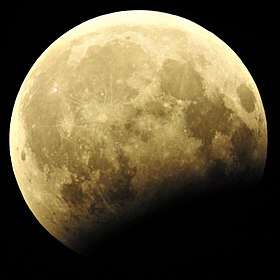October 1986 lunar eclipse
A total lunar eclipse took place on October 17, 1986, the second of two total lunar eclipses in 1986, the first being on April 24, 1986.[1]
| Total Lunar Eclipse October 17, 1986 | |
|---|---|
| (No photo) | |
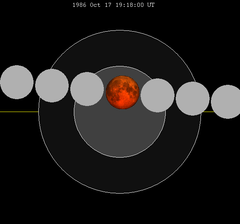 The moon passes west to east (right to left) across the Earth's umbral shadow, shown in hourly intervals. | |
| Series | 136 (18 of 72) |
| Duration (hr:mn:sc) | |
| Totality | |
| Partial | |
| Penumbral | |
| Contacts | |
| P1 | UTC |
| U1 | |
| U2 | |
| Greatest | |
| U3 | |
| U4 | |
| P4 | |
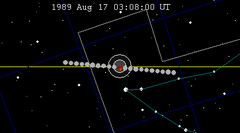 The eclipse occurs in Capricornus | |
Visibility
It was completely visible over Europe, Africa, Asia and Australia, seen rising over Europe, Africa on the evening of Friday, October 17, 1986, and setting over Asia, Australia on the morning of Saturday, October 18, 1986.
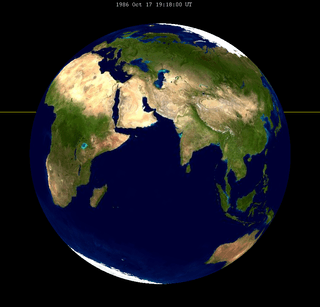
Related eclipses
Eclipses of 1986
Lunar year series
| Lunar eclipse series sets from 1984–1987 | ||||||||
|---|---|---|---|---|---|---|---|---|
| Ascending node | Descending node | |||||||
| Saros | Date Viewing |
Type Chart |
Gamma | Saros | Date Viewing |
Type Chart |
Gamma | |
| 111 | 1984 May 15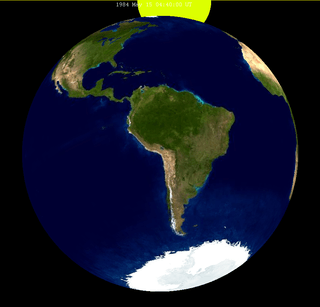 |
Penumbral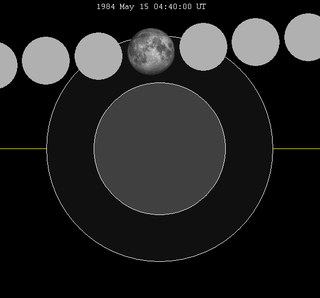 |
1.11308 | 116 | 1984 Nov 08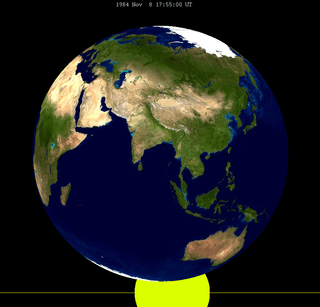 |
Penumbral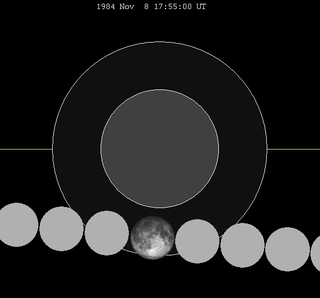 |
-1.08998 | |
| 121 | 1985 May 04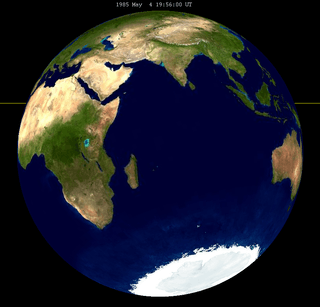 |
Total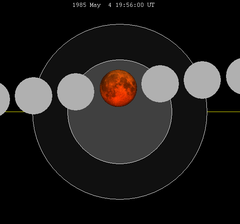 |
0.35197 | 126 | 1985 Oct 28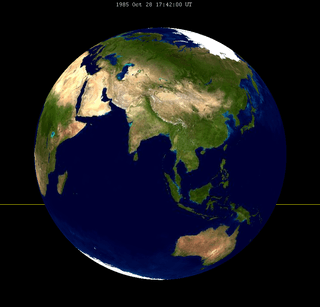 |
Total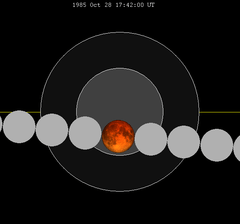 |
-0.40218 | |
| 131 | 1986 Apr 24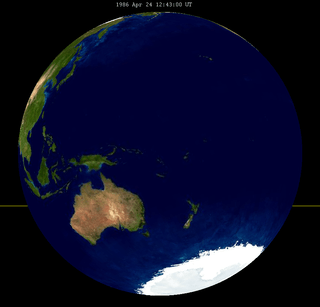 |
Total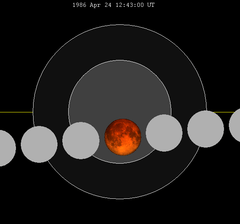 |
-0.36826 | 136 | 1986 Oct 17 |
Total |
0.31887 | |
| 141 | 1987 Apr 14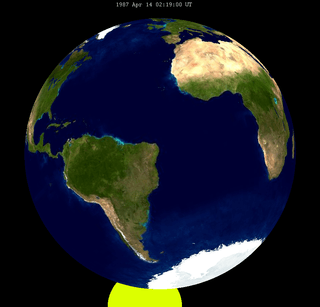 |
Penumbral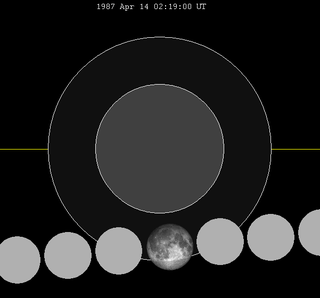 |
-1.13641 | 146 | 1987 Oct 07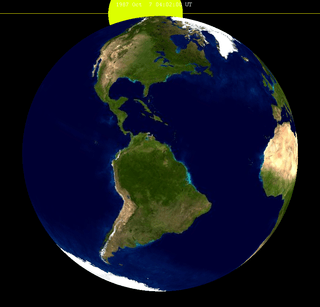 |
Penumbral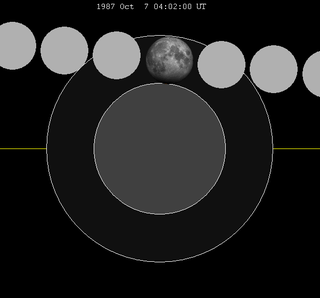 |
1.01890 | |
| Last set | 1984 Jun 13 | Last set | 1983 Dec 20 | |||||
| Next set | 1988 Mar 03 | Next set | 1988 Aug 27 | |||||
Metonic series
This eclipse is the third of four Metonic cycle lunar eclipses on the same date, October 17–18, each separated by 19 years:
The Metonic cycle repeats nearly exactly every 19 years and represents a Saros cycle plus one lunar year. Because it occurs on the same calendar date, the Earth's shadow will in nearly the same location relative to the background stars.
| Descending node | Ascending node | |||||
|---|---|---|---|---|---|---|
| Saros | Date | Type | Saros | Date | Type | |
| 111 | 1948 Apr 23.56 | Partial | 116 | 1948 Oct 18.10 | Penumbral | |
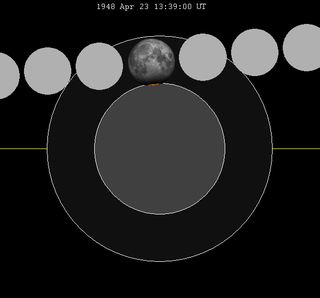 |
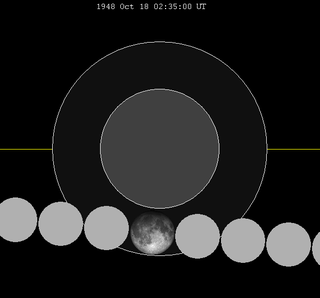 | |||||
| 121 | 1967 Apr 24.50 | Total | 126 | 1967 Oct 18.42 | Total | |
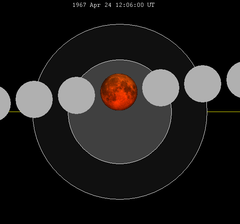 |
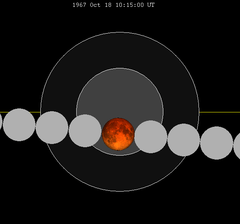 | |||||
| 131 | 1986 Apr 24.52 | Total | 136 | 1986 Oct 17.80 | Total | |
 |
 | |||||
| 141 | 2005 Apr 24.41 | Penumbral | 146 | 2005 Oct 17.50 | Partial | |
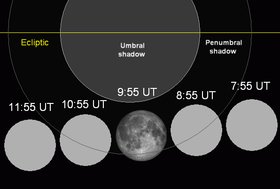 |
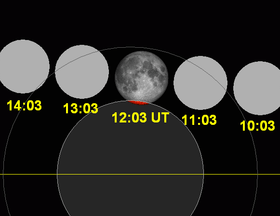 | |||||
Half-Saros cycle
A lunar eclipse will be preceded and followed by solar eclipses by 9 years and 5.5 days (a half saros).[2] This lunar eclipse is related to two total solar eclipses of Solar Saros 143.
| October 12, 1977 | October 24, 1995 |
|---|---|
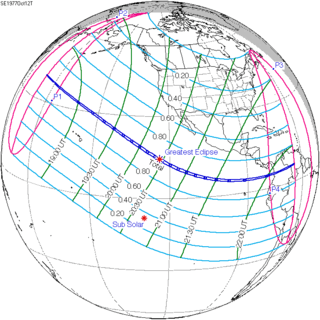 |
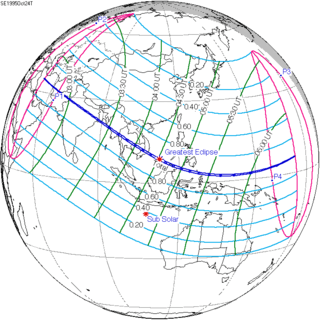 |
See also
- List of lunar eclipses
- List of 20th-century lunar eclipses
Notes
- Hermit Eclipse: Saros cycle 136
- Mathematical Astronomy Morsels, Jean Meeus, p.110, Chapter 18, The half-saros
